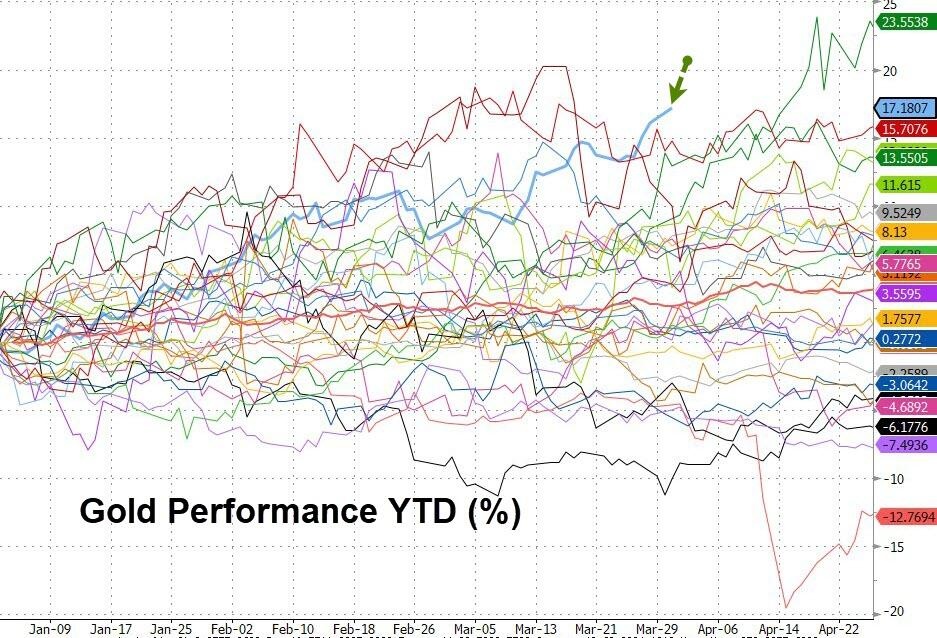In this scenario, the U.S. economic outlook will significantly deteriorate. Consumer prices may rise, real income will decrease, and corporate investment willingness will further decline. Morgan Stanley points out that in this situation, fixed-income assets (such as bonds) will be relatively beneficial, while the stock market may drop sharply, especially technology and cyclical stocks. Goldman Sachs' research report scenario analysis also shows that if the economy falls into recession, the S&P 500 index could drop to 4,500 points, a decline of about 12% from current levels.
Hedging Logic in the Crypto Market: Gold Rises, BTC Drops?
The rising risk-averse sentiment mentioned in the Goldman Sachs report (gold breaking new highs) also provides an interesting comparison for the crypto market. Traditionally, gold is viewed as the ultimate safe-haven asset, and BTC is often promoted as "digital gold". However, reality is not so simple. In the first quarter of 2025, gold prices rose 19%, while BTC dropped 15% during the same period, indicating that BTC's hedging attributes are still not fully recognized by the market in the face of true macroeconomic risks.

For blockchain investors, this is a phenomenon worth pondering. BTC's long-term value proposition (decentralization, inflation resistance) may be validated in the future, but in the short term, its price is more driven by macroeconomic conditions and market sentiment. Inflationary pressures caused by tariff policies may push up expectations of Federal Reserve rate cuts, and a low-interest-rate environment typically benefits assets like BTC. Therefore, if Trump's tariff policies ultimately lead to an economic hard landing, BTC may experience a short-term decline followed by a long-term rebound.
Market and Investor Response
Facing such uncertainty, how should investors respond? Goldman Sachs recommends overweighting high-quality stocks and defensive industries (such as healthcare and consumer staples). For crypto investors, flexibility and risk management are equally important. Here are a few suggestions:
- Focus on BTC and U.S. stock correlation: If the S&P 500 drops, BTC may follow suit, and investors can reduce risk exposure in the short term while waiting for clearer policy signals.
- Diversify investments: Besides BTC, pay attention to the stability and returns of stablecoins or DeFi projects to hedge market volatility.
- Long-term perspective: If tariff policies accelerate Fed rate cuts, a low-interest-rate environment may provide long-term support for BTC, making it suitable for buying on dips.
Global Perspective: Trading Partners' Reactions and Blockchain Industry Chain Effects
Trump's reciprocal tariff policy not only affects the U.S. economy but may also trigger dramatic adjustments in the global trade landscape. Major trading partners like Canada, Mexico, and the EU have indicated they will impose retaliatory tariffs, while China might retaliate by restricting rare earth exports. This will have profound impacts on global technology supply chains, especially the semiconductor industry. The blockchain industry heavily depends on chips (used for mining equipment and data centers), and if supply chains tighten, miner costs may rise, affecting BTC network hash rate and price.
Trump's reciprocal tariff policy is undoubtedly a heavyweight bomb for the global economy and crypto market in 2025. Whether mild adjustment or aggressive escalation, Wednesday's statement will provide some market signals, and investors need to quickly interpret and adjust strategies. Based on analyses from Goldman Sachs and Morgan Stanley, slowing economic growth and rising inflation are almost certain trends. BTC may follow U.S. stock fluctuations in the short term but still has rebound potential in the long term. On April 2nd, will the roses in Rose Garden wither under the cold wind of tariffs? For crypto investors, this might be a moment both dangerous and full of opportunities.






